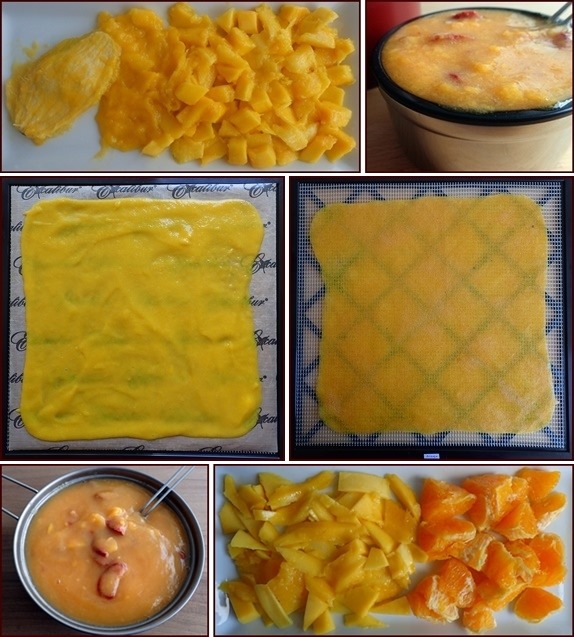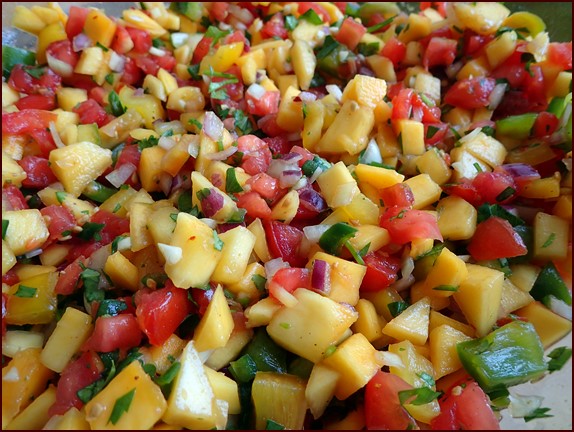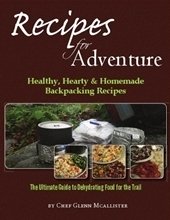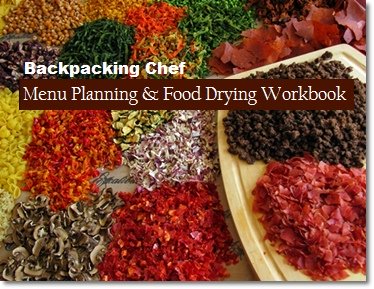Mango Fruit Leather Recipes
Get your mango-tango on with these mango fruit leather recipes. On the trail, tear off a strip for a quick snack, or rehydrate the mango leather with hot or cold water for smoothies and fruit puddings.
Is Mango Leather Healthy?
Yes. It's a superfood!
One tray of homemade mango leather (about 300 grams) provides approximately 200 calories and 20 different vitamins and minerals. Mangoes are high in vitamins C, A, B6, and B9; and they are also high in fiber and copper. Source: Mango.org.
Table of Contents
How to Make Mango Fruit Leather
Mango Smoothies with Coconut Milk Powder
How to Make Mango Fruit Leather
One large mango yields between 250 and 340 grams of fruit after the skin and pit are removed. After blending, you will have between 1 and 1½ cups of blended fruit. This is a good quantity to make one sheet of mango fruit leather.
Prepare the mango. Cut the mango all the way through closely along both sides of the flat pit. Slice the two outer pieces in half longwise and cut away the skin. Cut the fruit into smaller pieces for the blender.

Photo shows a mango cut into three sections.
There will be a little mango fruit clinging to the bottom of the skin. Scrape it off with a knife and add it to the blender.
The center part of the mango is harder to deal with, but it has juicy fruit that you absolutely want in your mango fruit leather mix. Cut off what you can from the pit, and then scrape off the rest with a stiff knife. Be careful; it’s slippery.
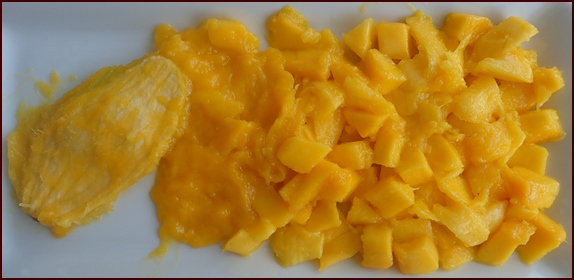
Photo shows a mango after cutting it into smaller pieces, including scrapings off the pit and from the underside of the skin.
Add fruit juice. Mango is thick when blended; add 3 tablespoons of fruit juice per mango to the blender to thin the mix. The extra juice will make it easier to spread the blended fruit on the dehydrator tray. Of all the fruit juices, lemon juice has the highest amount of citric acid, which reduces oxidation and helps fruit leather hold its color better. Lime juice is also high in citric acid, and can be used like lemon juice. However, too much lemon or lime juice will make the fruit leather too tart. That’s why we use 1 tablespoon of lemon juice and 2 tablespoons of orange juice.
Combine fruits. Mango fruit leather is delicious by itself, and it also combines well with other fruits, especially tropical fruits. Be careful not to cover up the mango flavor by using too much of the complimentary fruit. For the mango fruit leather recipes on this page, a 50-50 blend works well for mango/orange and mango/pineapple, but an 85-15 blend is better when pairing mango with banana or raspberry. There are no firm rules; have fun experimenting with the combinations.
Blend. Run the ingredients through a blender using the smoothie setting. Make sure no fruit pieces remain, as they may hold hidden moisture in the finished leather.
Dehydrate. Spread blended fruit leather mixture thinly on dehydrator trays covered with nonstick sheets, or use the fruit leather trays that came with your dehydrator. If using an Excalibur dehydrator, which has a higher capacity per tray than most other dehydrators, spread between 1 and 1½ cups of blended fruit on one tray. For smaller dehydrator trays, 1 cup of blended mango per tray will be about right.
Dehydrate mango fruit leather at 135°F (57°C) for approximately 9–12 hours. It will easily peel off nonstick sheets when dry, and will be pliable.
Flip trick: When the fruit leather is substantially dry, flip it over, peel off the nonstick sheet, and continue drying the leather directly on the mesh sheet for the last hour.
No Sweeteners Needed.
When making mango fruit leather from ripe mangoes, sweeteners are optional, but not necessary. Adding sweeteners will increase the stickiness of the leather. Spices are another option, but don’t overdo it or you will cover up the delightful mango flavor.
Here is a mango fruit leather recipe from the National Center for Home Food Preservation that uses honey and spices:
Ingredients: 4 cups mango purée, 1 cup honey, ½ tsp. cinnamon, ¼ tsp. nutmeg, and ¼ tsp. ground cloves.
Recipe makes 3-4 leathers.
Mango Fruit Leather Recipes
Each of the following mango fruit leather recipes makes one sheet of fruit leather weighing 50-60 grams. The ratios of the fruit combinations used are flexible, so let your taste preferences guide you. The finished leathers and dried fruit pieces used in rehydrated spoon smoothies and puddings are all interchangeable.
Any of the smoothie and pudding recipes can include shredded coconut and/or coconut milk powder to make them extra creamy and delicious.
Note: Coconut milk powder is not used in the fruit leathers, but is added later when you rehydrate them. You’ll find a few recipes with coconut on this page.
Just Mango Fruit Leather
Simple and delicious. The mango flavor shines.
Ingredients:
- 300 g mango, (approx. 1 mango)
- 1 Tbsp. lemon juice, not concentrated
- 2 Tbsp. orange juice
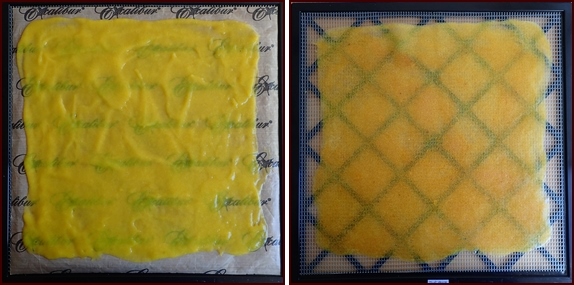
Photo shows mango fruit leather, before and after dehydrating.
Ginger-Mango Fruit Leather
A little extra zip for ginger lovers.
Ingredients:
- 300 g mango, (approx. 1 mango)
- 2 tsp. fresh ginger, finely minced
- ½ tsp. ground turmeric
- 1 Tbsp. lemon juice, not concentrated
- 2 Tbsp. orange juice
Pineapple-Mango Fruit Leather
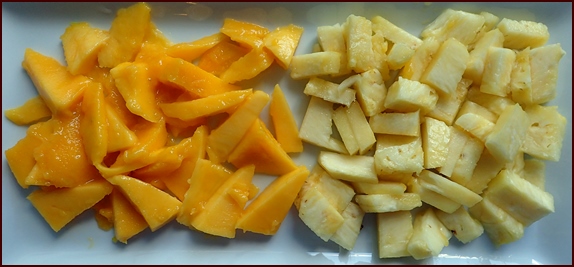
Ingredients:
- 150 g mango (approx. ½ a mango)
- 150 g pineapple (approx. 2-3 thick slices)
- 1 Tbsp. lemon juice, not concentrated
- 2 Tbsp. orange juice
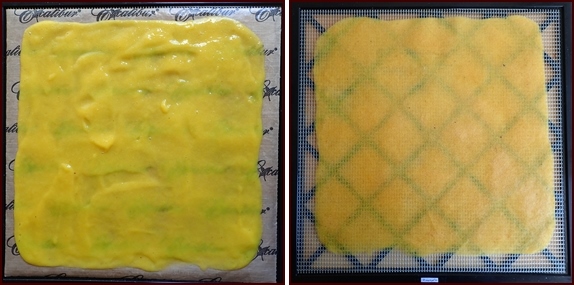
Photo shows pineapple-mango fruit leather, before and after dehydrating.
Orange-Mango Fruit Leather
Orange and mango make a colorful fruit leather. And they taste great together. Since oranges are juicy, there is no need to add extra juice.
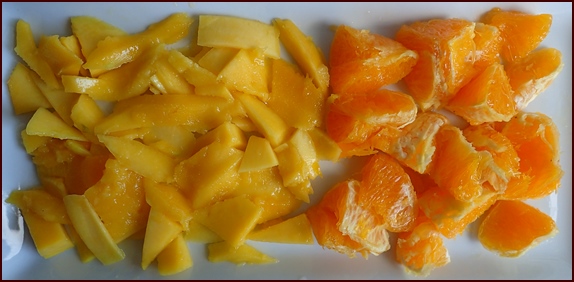
Ingredients:
- 150 g mango (approx. ½ a mango)
- 175 g orange (approx. 1 large orange)
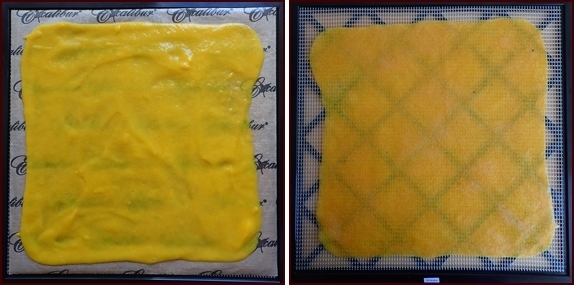
Photo shows orange-mango fruit leather, before and after dehydrating.
Banana-Mango Fruit Leather
Too much banana will cover up the mango taste, but a little is very nice. Banana tends to turn brown in fruit leather, so that’s another reason to use less.
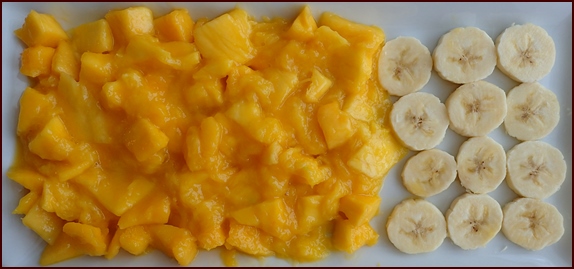
Ingredients:
- 300 g mango (approx. 1 mango)
- 50 g banana (approx. ½ a banana)
Makes about 1½ cups blended.
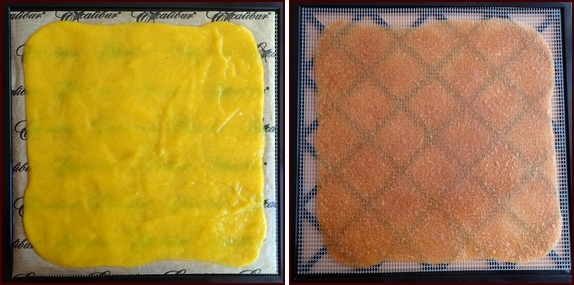
Photo shows banana-mango fruit leather, before and after dehydrating. Notice the color change caused by the bananas oxidizing and turning brown.
Raspberry-Mango Fruit Leather
Too many raspberries will completely cover up the mango flavor, but the color is bright and the leather is tasty.
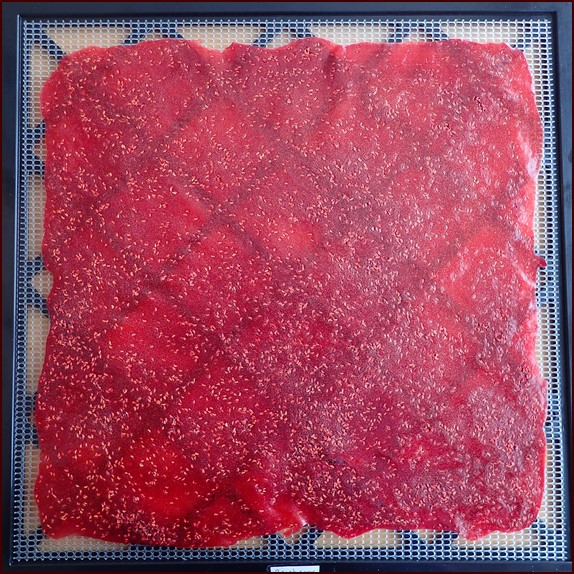
Photo above shows a 50-50 blend of raspberry and mango. I used less raspberry in the following recipe. Notice that the leather is full of raspberry seeds. I improved the leather by straining out the seeds.
How to strain out raspberry seeds:
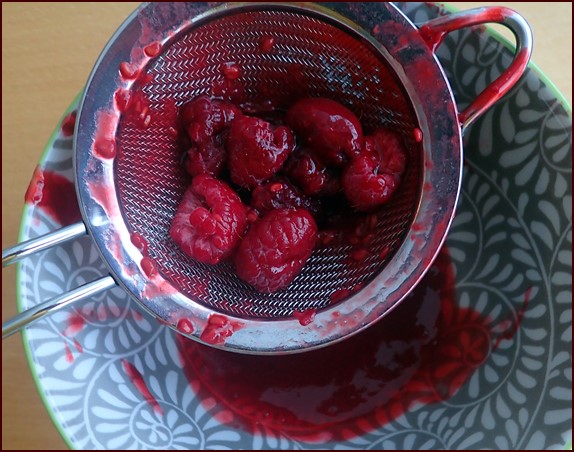
Place a few raspberries at a time in a strainer and press down hard with a spoon. When you have nothing but seeds and pulp left in the strainer, transfer the seeds to a separate bowl. Repeat the process until you have strained all the raspberries.
Add 1 tablespoon of the fruit juice called for in the recipe to the bowl with the seeds and work it strongly into the seeds. Return seed slurry to the strainer and push the contents through, into the bowl from the first pass. Repeat process with the other 2 tablespoons of juice.
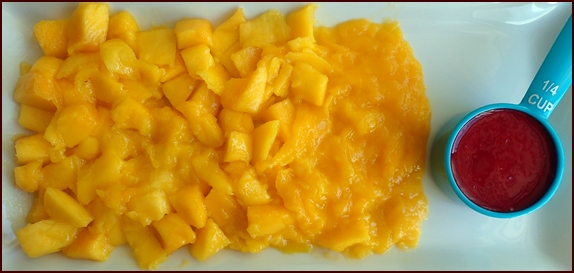
Photo shows mango with seedless raspberry juice. You’ll need about 30 grams of raspberries to make 2 tablespoons of seedless raspberry juice.
Ingredients:
- 300 g mango (approx. 1 mango)
- 2 Tbsp. seedless raspberry juice, which contains the lemon and orange juice
- 1 Tbsp. lemon juice (strained through raspberries)
- 2 Tbsp. orange juice (strained through raspberries
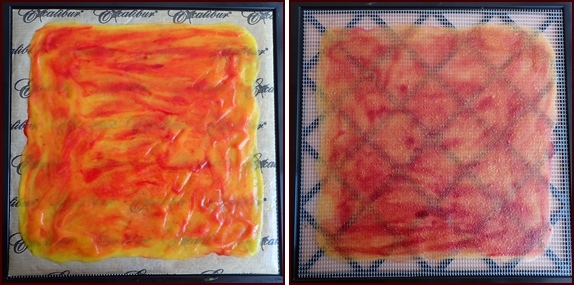
Photo shows raspberry-mango fruit leather, before and after dehydrating. I tried to do something creative by swirling the raspberry into the blended mango, but the quick and easy method is to combine the raspberry and mango in the blender.
How to Make Smoothies with Mango Fruit Leather
Mango fruit leather is great for snacking on “as is,” but it is super refreshing when reconstituted into a smoothie. You can make one with just mango leather, or you can add complimentary dried fruit pieces to it.
Orange-Mango Spoon Smoothie with Raspberries
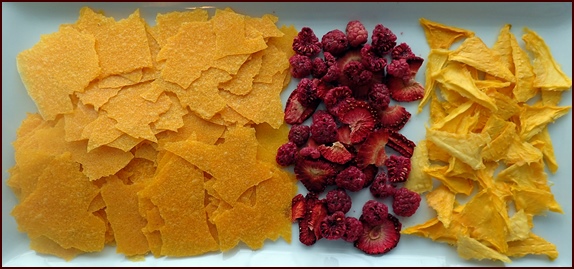
Photo shows ingredients for Orange-Mango Spoon Smoothie.
Servings: 1-2
Ingredients:
- 1 sheet of orange-mango fruit leather (50-60 g)
- ¼ cup dried raspberries or strawberries (8 g)
- ¼ cup dried mango (12 g)
- 1¾ cup cold water to rehydrate
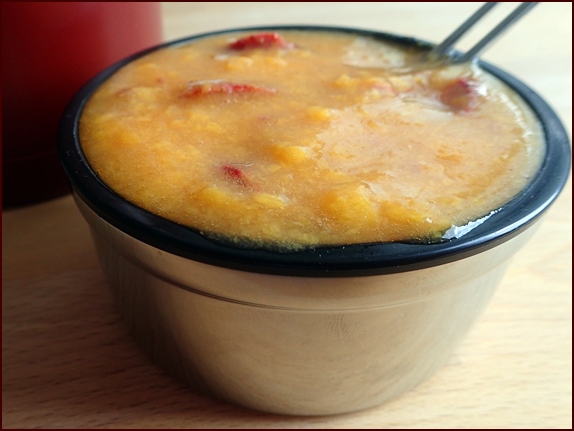
Photo shows one of two servings of an Orange-Mango Spoon Smoothie with raspberries.
On the Trail:
Use this procedure for all of the smoothie recipes that follow.
Combine all ingredients with cold water in a container with a good lid. A thermos food jar is the ideal container because it won’t leak, and the smoothie will stay cold for hours.
Shake container vigorously when you combine the ingredients, and shake again before serving. Wait at least 1 hour for best results. Add the water after lunch, and enjoy the smoothie later in the afternoon. Likewise, you can add the water before going to sleep, and enjoy the smoothie for breakfast.
Ginger-Mango Spoon Smoothie with Pineapple
Servings: 1-2
Ingredients:
- 1 sheet of ginger-mango fruit leather (50-60 g)
- ½ cup dried pineapple (25 g)
- 1¾ cup cold water to rehydrate
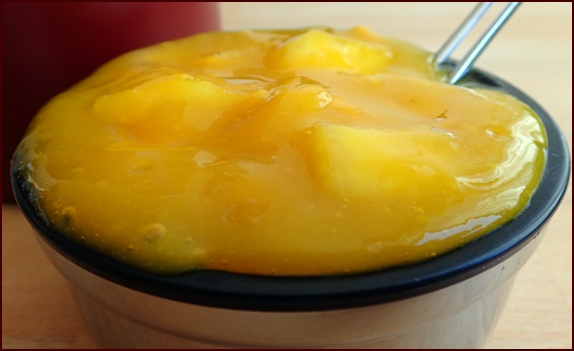
Photo shows one of two servings of a Ginger-Mango Spoon Smoothie with Pineapple.
Raspberry-Mango Spoon Smoothie with Orange
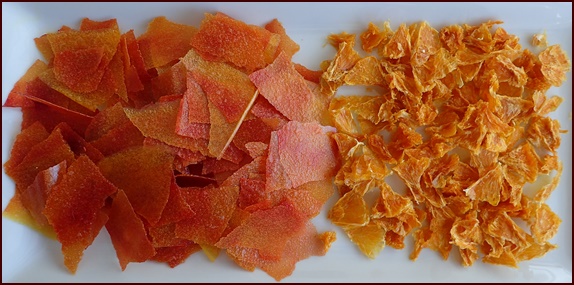
Servings: 1-2
Ingredients:
- 1 sheet of raspberry-mango fruit leather (50-60 g)
- ½ cup dried orange (25 g)
- 1¾ cup cold water to rehydrate
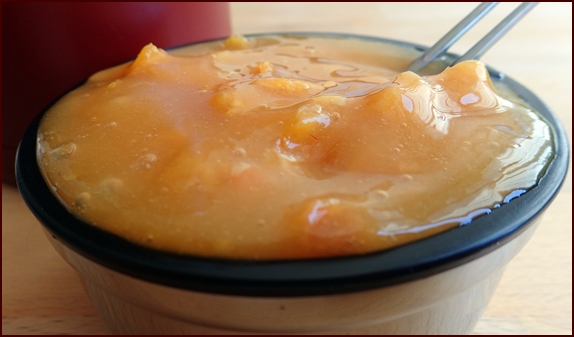
Photo shows one of two servings of a Raspberry-Mango Spoon Smoothie with Orange.
Tropical Mango Spoon Smoothie with Coconut Milk
This spoon smoothie recipe introduces coconut milk powder into the mix. You can add coconut milk powder to any of the previous smoothies also. The main change is that you increase the amount of water for rehydration.
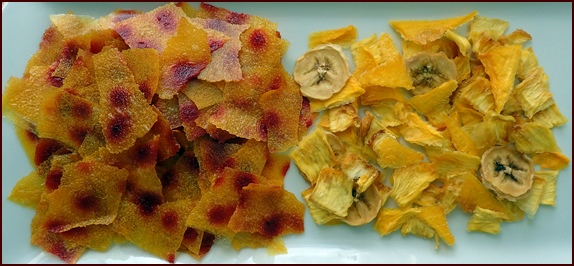
Photo shows raspberry-mango fruit leather (another attempt at creativity) with dehydrated tropical fruits—mango, pineapple, and banana.
Servings: 1-2
Ingredients:
- 1 sheet of raspberry-mango fruit leather (50-60 g)
- ½ cup dried tropical fruits—any combination of mango, pineapple, and banana (30 g)
- 3 Tbsp. coconut milk powder
- 2¼ cups cold water to rehydrate
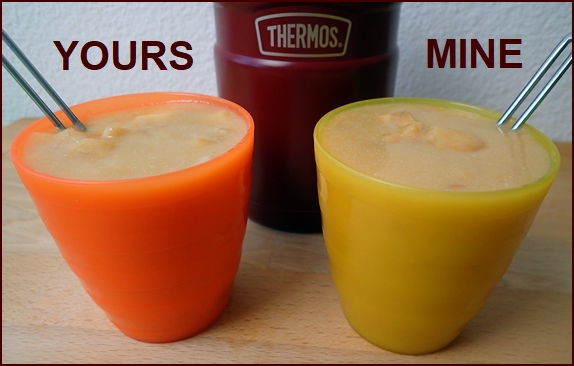
Photo shows two servings of Tropical Mango Spoon Smoothie with Coconut Milk.
On the Trail:
Combine all ingredients with half the cold water in a container with a good lid. Shake vigorously. Coconut milk powder mixes easily with hot water, but it takes more agitation to dissolve it in cold water. Starting with half the water ensures a hearty shake. After shaking the container strongly, add the rest of the water and shake it some more. Then shake it one more time before serving.
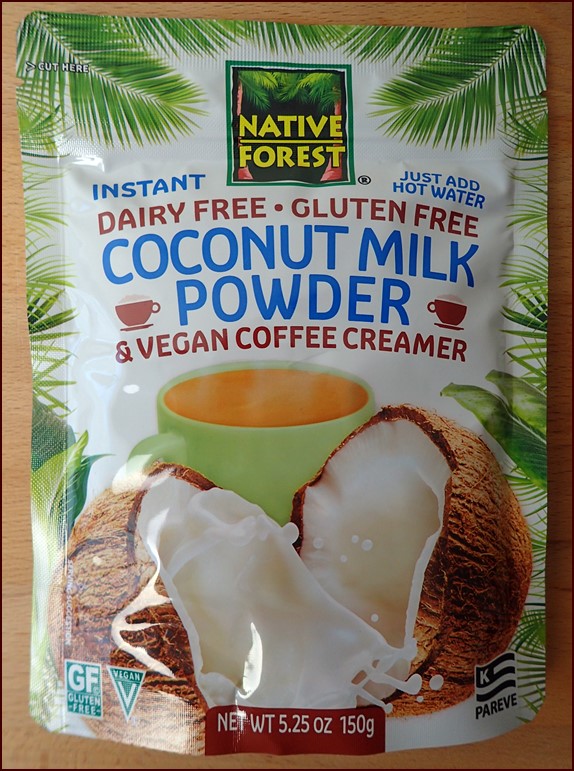
Coconut Milk Powder
Native Forest Coconut Milk Powder or Anthony's Organic Coconut Milk Powder work great in cold smoothies and hot puddings.
Buy on Amazon:
Disclosure: Backpacking Chef participates in the Amazon Associates Program and may earn a commission if you make a purchase. Thank you!
How to Make Hot Pudding with Mango Fruit Leather
The first pudding recipe uses coconut milk powder, and the second pudding recipe uses shredded coconut. If you’re not fond of coconut, you can turn mango fruit leather into pudding without it. As with spoon smoothies, the fruit leathers and dried fruit pieces are interchangeable. Have fun combining your favorite flavors.
Banana-Mango Fruit Pudding with Coconut Milk
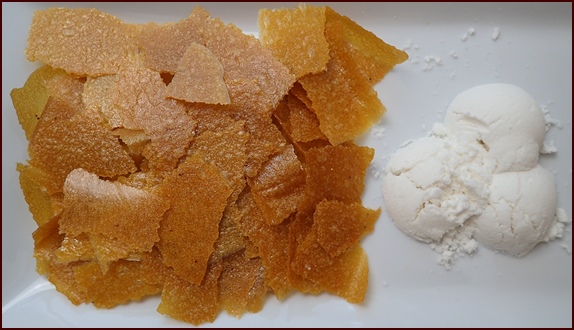
Photo shows one sheet of banana-mango fruit leather and three tablespoons of powdered coconut milk.
Servings: 1
Ingredients:
- 1 sheet of banana-mango fruit leather (50-60 g)
- 3 Tbsp. coconut milk powder
- 1¼ cup hot water to rehydrate
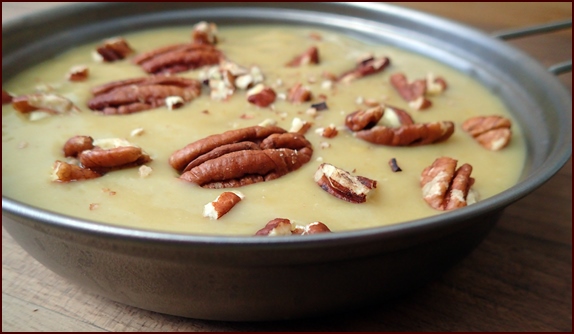
Photo shows one serving of Banana-Mango Fruit Pudding with Coconut Milk. Optional garnish with pecan pieces.
On the Trail:
Add banana-mango-fruit leather to pot with water. Light stove. As soon as water is warm, stir in the coconut milk powder. Continue stirring until leather dissolves and desired temperature is reached. If you can control the flame on your backpacking stove, use low flame. Pudding will be ready in ten minutes or less. Garnish with pecans or almonds.
Mango-Berry Fruit Pudding with Coconut
This pudding uses shredded coconut for extra texture and a wonderful tropical taste.
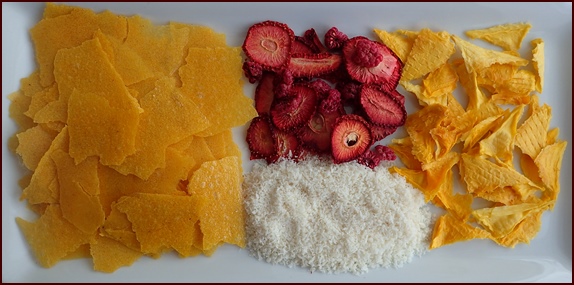
Servings: 1-2
Ingredients:
- 1 sheet of mango fruit leather, any kind (50-60 g)
- ¼ cup dried raspberries or strawberries (8 g)
- ¼ cup dried mango (12 g)
- ¼ cup shredded coconut, unsweetened (25 g)
- 1½ cup hot water to rehydrate
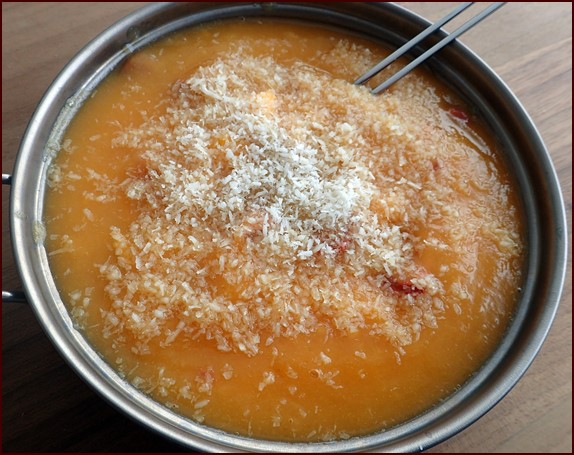
Photo shows one serving of Mango-Berry Fruit Pudding with Shredded Coconut.
On the Trail:
Add dried fruit pieces to pot with water. Wait 5 minutes and light stove. When water is very hot, add the mango fruit leather and turn off the stove. Stir until leather dissolves into a smooth pudding texture. Stir in shredded coconut before serving.
Try Bob's Red Mill Shredded Coconut, Unsweetened.
How to Pack & Store Mango Fruit Leather
It is important to pack and store fruit leather as soon as it has cooled after coming out of the dehydrator. If left out too long, it will reabsorb moisture from the air, which will increase stickiness and could lead to mold growth. If you forget about your fruit leather in the dehydrator for several hours, or even a day, simply turn the dehydrator back on for an hour to evaporate any gained moisture.
Fruit leather will stick to itself if you don’t wrap or roll it up in plastic wrap or parchment paper (aka baking paper). I prefer baking paper because the paper has a second use on the trail as a sanitary food prep surface.
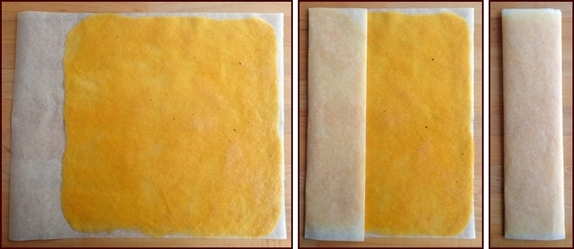
Cut a piece of baking paper about three inches wider than the fruit leather.
Fold the extra paper over first, then continue folding the leather so you end up with four columns folded into one. Then fold in half the other way.
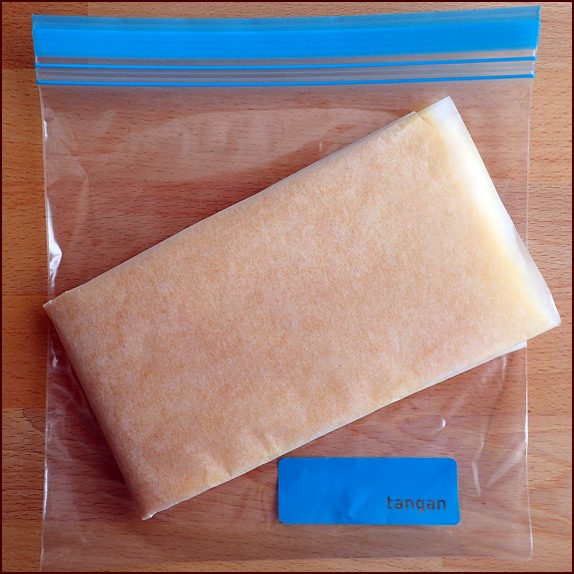
Photo shows one folded sheet of mango fruit leather.
You can fit several folded fruit leathers in one quart-size Ziploc bag. For long-term storage and transport on the trail, an 8-inch wide vacuum seal bag will preserve several leathers.
Pack fruit leather separately from dehydrated fruit pieces for smoothies and pudding, and use separate bags for coconut milk powder or shredded coconut.
For home use, such as for kids’ lunch boxes, make mango fruit roll-ups by rolling the fruit leather in baking paper. Cut across into individual servings. Store several fruit roll-ups in a Ziploc bag or Tupperware container in the refrigerator.
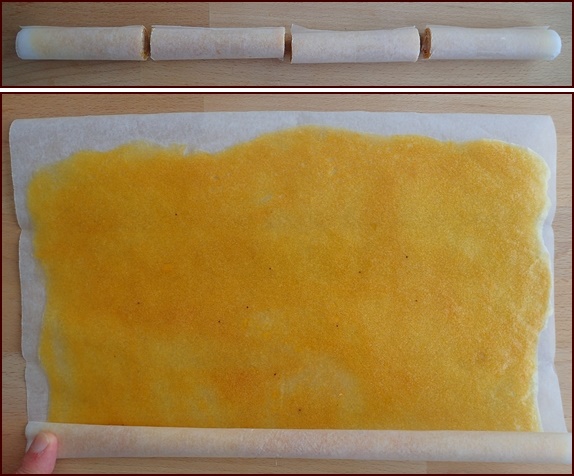
And that's a wrap for learning all about dehydrating mango fruit leather.
Food Drying & Trail Cooking Gear Guide
Products to help you with your food drying projects and trail cooking adventures. I use the featured products regularly, or they are recommended by Backpacking Chef readers.
Share this page with friends on social media.
Free E-book & Newsletter
Free with Trail Bytes subscription.
Dehydrating Food from A–Z

